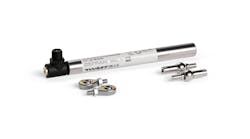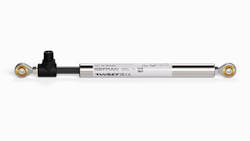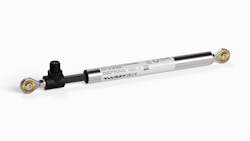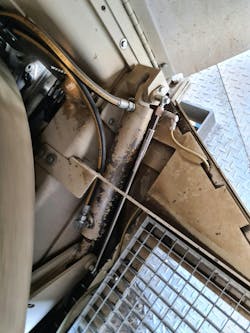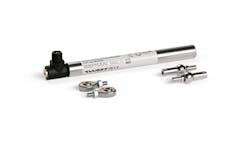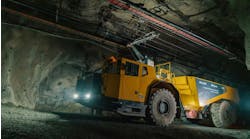Today’s hydraulic systems often include an array of sensors which monitor various parameters. However, there is an increasing need for simpler, more compact systems – leading many to rethink how hydraulic and sensor components are designed.
Enter the Gefran Twiist, a contactless linear position transducer for mobile and industrial hydraulics capable of providing multiple measurements in a single unit.
According to Ron Akers, business development manager for fluid power at Gefran Inc., the company spent about 10 years researching and developing the sensor in partnership with the engineering department at the University of Brescia in Italy, where the company is headquartered.
By using a helical magnetoelectronic design, Gefran believes Twiist overcomes challenges associated with other sensor types in the market. Commonly used magnetostrictive and LVDT (linear variable differential transformer) sensors are capable of providing accurate linear position measurements but have limited mechanical flexibility and are quite expensive, said Ann Thompson, marketing manager at Gefran Inc. Meanwhile, potentiometric technology is more affordable and offers mechanical flexibility but there is a lack of development for communication protocols used with these sensors.
Twiist, on the other hand, is less expensive than magnetostrictive and LVDT sensors and is mechanically self-aligning which makes it a flexible and easy-to-install option. It also features a more robust design than potentiometric sensors as it is resistant to wear, water, dust, shock and vibration. This ensures long-lasting use in a variety of mobile and industrial hydraulic system applications.
The sensor is similar in look and shape to a standard potentiometer. Akers said developing it around the potentiometer platform, which is intended for linear movement, makes it easier to install because Twiist resembles a common sensor in the market and therefore is familiar to those who will be using it. If multiple sensors were instead used, there would be different shapes, mounting and other considerations to take into account which can make installation more difficult.
In addition, the Twiist sensor is available with analog and digital outputs to suit a range of application needs. Models with CANopen fieldbus and IO-Link outputs can digitally transmit measurements for process variables – such as position, speed and inclination – up to 1,000 times per second which helps to provide consistent monitoring of machine performance.
Read more about the design and features of the Twiist sensor.
The Benefits of Using a Single Sensor for Multiple Measurements
By incorporating several measurements into a single sensor device, Twiist enables the creation of more compact and simplified designs. For the latter, Akers noted the amount of wiring needed in a machine is reduced when using fewer sensors which not only helps to simplify designs but also minimizes the amount of labor necessary to build a system or machine, providing additional value to a manufacturer.
With fewer components to install, the time it takes to build a hydraulic system or full machine can be reduced as well, further reducing costs for manufacturers and helping them get product to market faster which continues to be an area of focus for many.
A reduction in system components also means fewer failure points, improving maintenance for end-use customers. This also makes it easier to troubleshoot a system or machine because there are not as many components to test in order to determine what issue may be occurring said Akers.
System designers can also benefit from using a single sensor device like Twiist. For those who may be programming a machine, he said the various measurements provided by the sensor can be put into a software device so the information can be viewed in real time and used to help program a machine if desired.
It also opens up opportunities for controls engineers who can utilize information gathered by the sensor for different formulas. “Now they can calculate accelerations, speeds of different movements; it can even analyze vibration of the machine if they want it to,” explained Akers. “It opens the door for many different opportunities.”
A Wide Range of Use Cases Possible
Akers refers to Twiist as a crossover style of sensor because it can be used in numerous mobile and industrial hydraulic system applications. Construction machinery and material handling equipment are some of the target mobile applications he sees for the sensor.
In forklifts, for instance, Twiist can provide the fine positioning required for the mass tilt and side shift features of the forks. It can also be used as part of an auto-leveling feature which allows machine operators to essentially push a button and have the machine take care of placing the fork at the exact level needed. This helps to ensure accuracy of material collection and placement as well as improve productivity by reducing an operator’s cycle time. “For the operator, when they are picking up material, they don’t have to think about [whether or not] the fork is level as it goes into the material and picks it up,” said Akers. “Every second they can save on their cycle times…is more profitable for the business and efficient for the machine.”
As the sensor is based on the concept of a potentiometer, it is beneficial for steering control in different types of vehicles. Akers explained the sensor can measure the position of a vehicle’s front axle like a traditional potentiometer. With its additional measurement capabilities, it can also determine how a vehicle’s suspension acts as it maneuvers over various terrain. “That can be used by the software to keep the carriage of the vehicle level,” he said, helping to keep operators as well as any possible cargo comfortable and safe.
Thompson noted additional application uses for the Twiist sensor include controlling stabilization footings in area platforms; monitoring position and vibration for mining, fracking, and drilling; as well as measuring position and inclination for the arms on agricultural sprayers.
Industrial use cases for the sensor include:
- bending rolls parallelism control in metalworking machines,
- control of abrasive wheel positioning in marble and stone processing machines, and
- mechanical dancer position control feedback in packaging and labeling machines.
She said the sensor is also able to provide feedback control in hydraulic and pneumatic cylinders, benefiting both sectors of the fluid power industry.
Technological Progress for Sensors in Fluid Power
During his career, Akers has witnessed the technological evolution of hydraulic components over the years, including improvements in and increased use of sensors. “Now they [sensors] are more perfected for hydraulic pump control by controlling the flow of oil to be more on demand versus having the pump run at full capacity at a constant rate,” he said.
This helps to conserve power for reduced energy or fuel use, leading to increased efficiency which everyone is looking for these days in both industrial and mobile applications. And as the mobile sector moves more toward electric-powered alternatives, efficiency will be vital to provide desired battery range.
Many of the technological advancements taking place in the industry, including greater use of sensors, come from the mobile hydraulics sector catching up with what has been happening in the industrial market. Akers said it seems engineers from both sides of the hydraulics industry are talking with each other more to share ideas and those from the industrial space are being brought into the mobile equipment market to help achieve greater efficiency and other aspects.
Data collection and how that can be used to improve performance, maintenance or even future designs is part of this evolution as well.
Going forward, Akers sees more wireless and Bluetooth communication being utilized to help reduce the amount of wiring within machines. He said that type of technology should work well as long as there is no outside interference which could negatively impact the signals.
Further consolidation of components and systems are possible as well, such as putting data storage on a device, to help reduce the number of components necessary in a machine as well as the overall size of a system – which can lead to smaller, more efficient machines.
Artificial intelligence (AI) will likely play a greater role in the future as well to help with equipment diagnosis. This capability is already available in some capacity but is still in its early stages – and only likely to become more advanced and offer new opportunities in the coming years.
